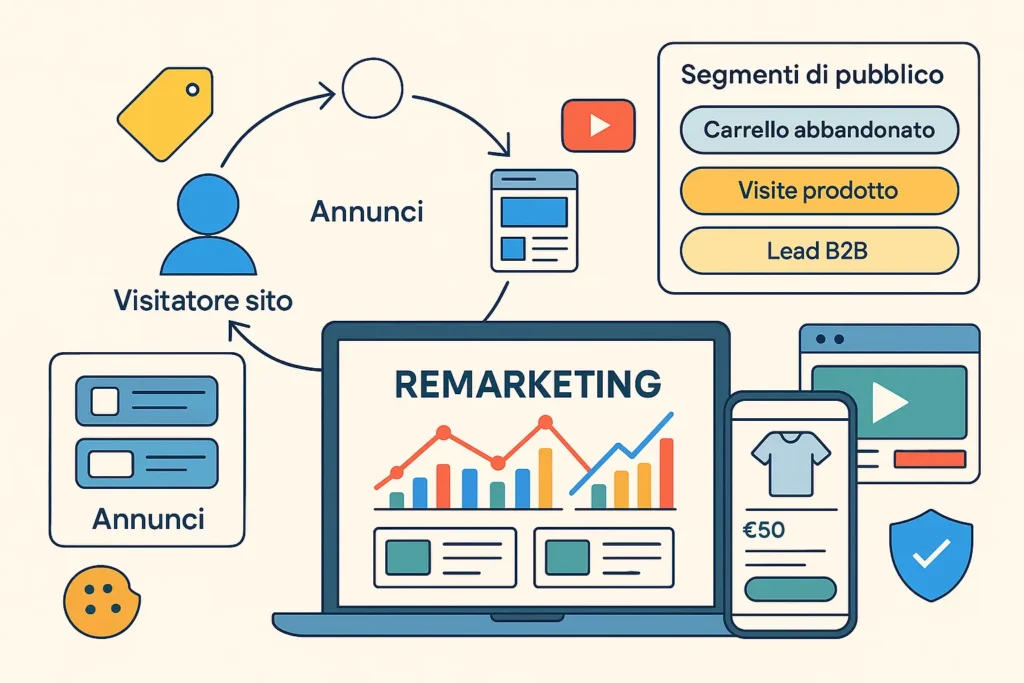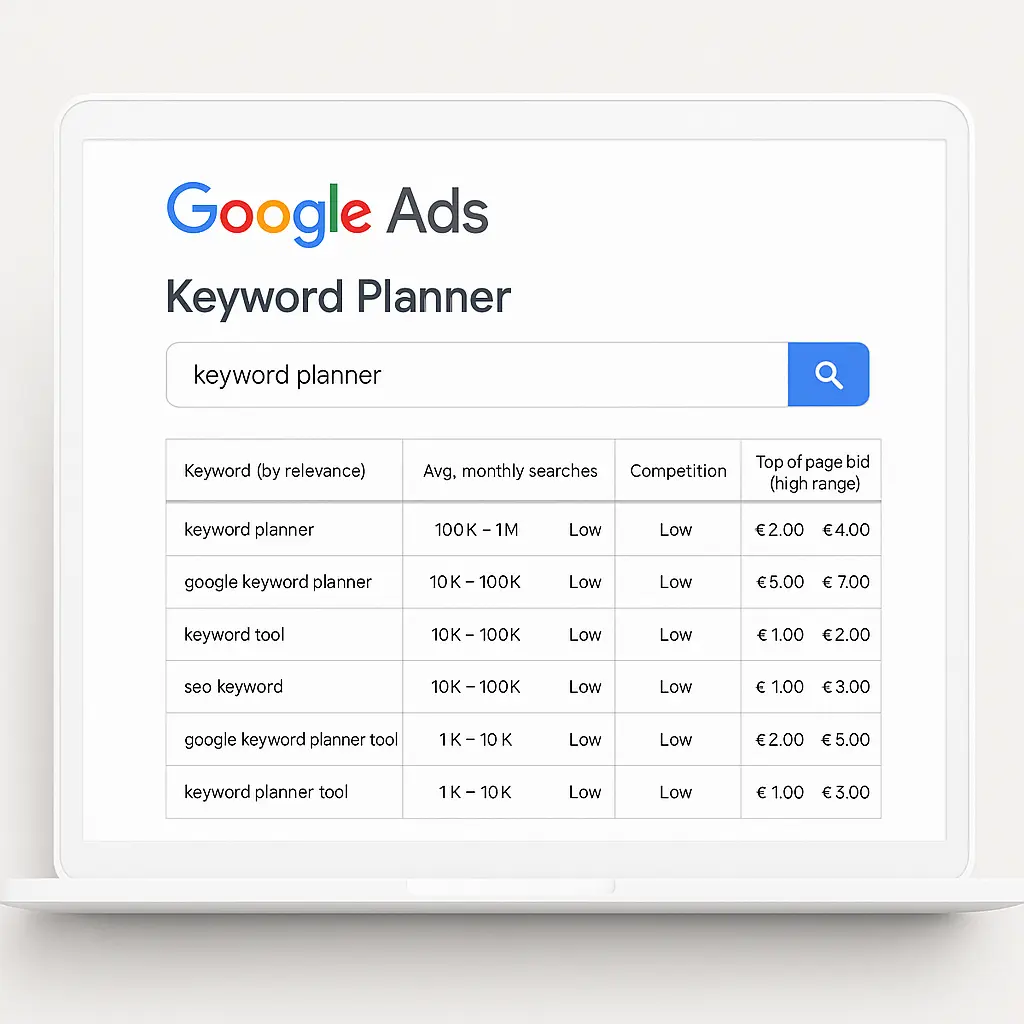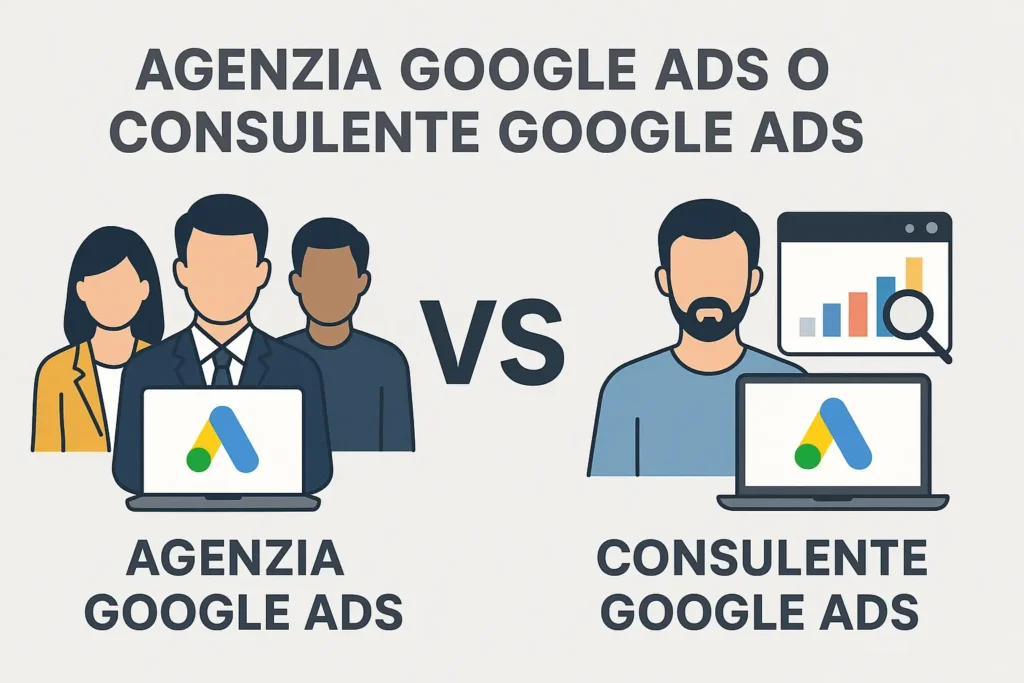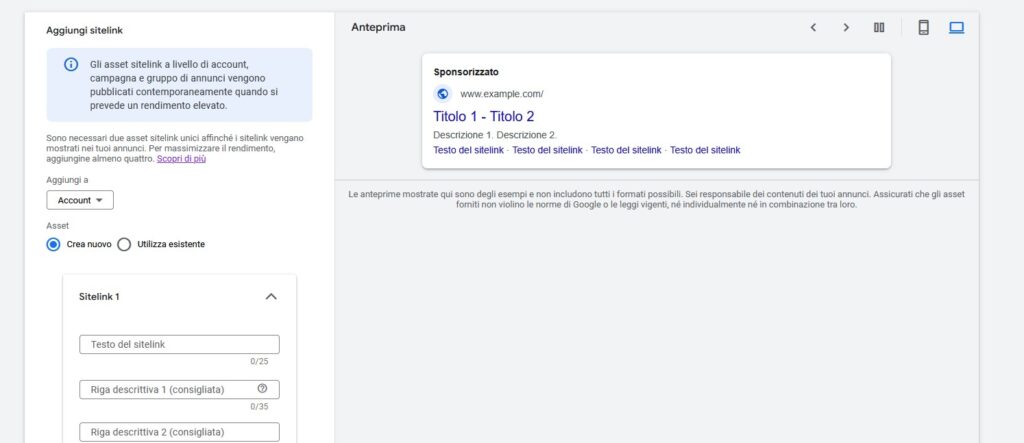What is the Keyword Planner tool for?
The Keyword Planner is a free Google Ads tool designed for advertisers who want to better plan their advertising campaigns. With this tool, we can identify the most relevant keywords for our business, analyse their search volume and competitiveness among advertisers, and get an estimate of the cost per click (CPC). The power of the Keyword Planner lies in its ability to combine historical Google search data with future predictions, so that we can estimate the results of possible campaigns. In practice, we can discover new search terms to target, understand how many people search for those words each month, and understand how much it might cost to advertise to reach those searching for those terms. This tool is extremely useful both for those who want to launch a new Google Ads campaign tailored to their audience and for those interested in keyword research for SEO and SEM optimisation. Thanks to Keyword Planner, we can make more informed decisions about keyword selection, campaign budget and audience targeting, saving time in the preparation phase.
Keyword research and new market opportunities
Keyword research: this tool helps us discover the most relevant keywords for our business. We can enter a generic term that describes our product or service and get a list of related words, displaying the average search volume for each one. This allows us to identify ideas for content (blogs, articles, product pages) or Google ads that match users’ searches exactly. In addition, by analysing related keywords, we can discover frequently asked questions or new search trends in our industry. This keyword research process is essential for both SEM campaigns (to find which search terms to use in ads) and SEO, because it tells us what topics and queries users are searching for in the market.
Campaign planning and budget definition
Campaign planning: the real advantage of this tool is the ability to define a concrete advertising plan. We can add the selected keywords to the plan and assign a reference budget to understand what we can expect. For example, by setting a daily budget, we can see an estimate of how many clicks, impressions and conversions we could get, considering the suggested CPCs. This allows us to predict the results of the campaign in advance: if the numbers are not sufficient, we can adjust the bid or expand the keyword list. The Keyword Planner also shows us the cost-per-click bids for the first page (low and high) for the chosen keywords: this helps us evaluate how much to invest to compete effectively. Thanks to these budget and bid estimates, we can plan more accurate campaigns, allocate adequate resources to keywords and optimise Google ads based on expected results.
How the Keyword Planner works
To use the Keyword Planner, you first need to log in to your Google Ads account (a free Google account is sufficient). Within the platform, you will find the keyword planning tool in the tools – planning menu. Once you have opened the tool, you will see two main options: you can choose to discover new keywords or get search volumes and forecasts for keywords you already know and want to evaluate. In the first mode, you enter terms or URLs related to your business and the tool generates a list of related keywords, showing for each one the estimated average monthly search volume, the level of competition among advertisers and the estimated CPC. In the second mode, we can upload or manually enter a list of keywords already identified (e.g. from previous analyses) to obtain the relevant historical search volumes, competition and a suggested cost per click bid. In both cases, we can select targeting parameters such as geographical location (country or city), language and time period, in order to make the data more relevant to our campaign. In addition, we can customise the output by applying additional filters, for example by specifying product categories or excluding negative keywords. In this way, the Keyword Planner provides a set of data tailored to our advertising needs.
Generate keyword ideas and suggestions
One of the most useful tools in the Keyword Planner is the Discover new keywords section. In this section, we can generate keyword ideas from search terms (keyword seeds) or a reference URL (e.g., a competitor’s website or product page). In practice, we enter one or more terms that describe our product or service, and the tool returns a list of related keywords. The list usually includes both generic and long-tail keywords, allowing us to identify less obvious but still relevant opportunities.
For example, if we sell running shoes, we can enter “running shoes” and get ideas such as “men’s running shoes”, “women’s running shoes” or “sports shoes”, with relative search volumes and competition. We can then use filters (e.g. by language, location or theme) to refine the results: we can exclude certain terms, include only certain regions or add words from a list. This allows us to narrow down the search to the keywords most relevant to our target audience and our advertising message.
Create a campaign plan and analyse forecasts
With the Get search volumes and forecasts mode, we can work from a different perspective: we don’t look for new ideas, but analyse keywords we already know. In this section, we can upload a list of keywords (e.g. terms identified previously or suggested by external sources) or type in words of interest. The Keyword Planner then returns aggregated data for each term: in addition to the average monthly search volume and level of competition, it indicates the suggested cost per click to rank at the top of the paid search results. In practice, we can use this feature to create a customised keyword plan: we choose the most relevant keywords and add them to the plan to monitor their effectiveness. The plan shows advertising performance forecasts: based on a reference budget (e.g. £10 per day), it estimates the number of clicks, impressions and possible conversions we could achieve. This information helps us plan our investment: we can compare different budget scenarios or modify keyword bids and understand how the potential coverage of our advertising campaign changes.
Interpreting the results: search volumes, competition and CPC
Once we have obtained a list of keywords from the Keyword Planner, we need to interpret the main data in order to select the most suitable ones. The results table generally includes three key indicators: the average monthly search volume (how many times a month users search for that keyword), the competition (or competitiveness) between advertisers for that keyword, and the suggested cost per click (CPC) for advertising. We need to look at these values in the context of our objectives: for example, a term with a high search volume but also high competition could bring in a lot of visits, but will require a high budget to achieve visibility. Conversely, terms with lower search volumes and limited competition may be easier to rank with a small budget, even if they will bring in less traffic. In summary, it is important to balance search volume, level of competition and CPC to identify keywords that are relevant to our audience and sustainable for our budget. In the following paragraphs, we will take a closer look at each indicator: we will understand how to read search volume, what competition means and how to use cost-per-click estimates to plan our campaign effectively.
Search volume: meaning and use
Search volume indicates how many times, on average per month, users search for a certain keyword on Google. In the results column, Google reports the average monthly searches for that keyword, often with a range or specific numbers. This metric is essential because it gives us an idea of the market demand for that keyword. In general, keywords with high search volumes potentially bring more traffic, but are often more competitive. It is important to note that Google provides this data as an average, and it may vary over time or depending on location. For example, a keyword that is popular throughout the UK may have a much lower volume when considered in a small town. Furthermore, search volume does not distinguish between long-tail keywords or similar search variants: the table often includes a “related keywords” section that groups together variants of a term.
It is important to combine average volume analysis with tools such as Google Trends to understand whether the search trend for a keyword is growing or declining. Understanding search volume allows us to estimate how many users we could reach with a campaign on a given keyword.
Competition between advertisers (competitiveness)
The value of competition (or keyword competitiveness) indicates how much competition there is between advertisers for a given keyword. In practice, Google Ads classifies competition as high, medium or low based on the number of advertisers bidding on that keyword. High competition means that many companies are targeting that term, so the cost of gaining visibility will be higher. Terms with low competition, on the other hand, may indicate less exploited niches or specific long-tail keywords: they are easier to include in campaigns with limited budgets, but bring less traffic.
For us marketers, it is essential to balance competition and objectives: a strategic keyword can be worthwhile even if it is competitive, if it brings qualified traffic. We can filter the results to show only keywords with low or medium competition if we want to reduce costs, or explore high-competition terms if our budget is high. In any case, understanding the level of competition helps us define the targeting and bidding strategy for the advertising campaign.
Suggested cost per click and budget planning
The estimated cost per click (CPC) indicates Google’s suggested bid to place the ad in the top positions. In the Keyword Planner table, we will often find two values: the suggested low bid and the suggested high bid, which represent a typical price range that advertisers pay for the top spot in SERPs. These values are calculated based on historical Google Ads data and help us predict how much budget will be needed to cover certain keywords.
For example, if a keyword has an average suggested CPC of £1.50, it means that we will have to bid at least that amount to gain visibility. The Keyword Planner allows us to enter a budget and see how many impressions and clicks we can expect: for example, with £10 per day, we could get a certain number of clicks, while with £5, we would probably get half that. Understanding the estimated CPC is therefore useful for balancing your spending budget with your campaign’s coverage and conversion goals. Of course, the actual CPC may vary depending on other advertisers’ bids and quality scores, but these reference values give us a concrete starting point.
Keyword Planner for SEO and advertising campaigns
Although it was created to support paid campaigns, Keyword Planner is also a valuable tool for keyword research in SEO. For a marketing team, this means being able to leverage Google Ads data to guide both PPC campaigns and organic content strategies. From a SEM (Search Engine Marketing) perspective, we use Keyword Planner to define the targeting of Google ads and maximise ROI: we identify the keywords to focus on and plan bids based on volumes and suggested CPCs. From an SEO perspective, on the other hand, Keyword Planner helps us discover relevant topics and long-tail keywords to include in our content.
For example, we can search for variations of a main keyword with good search volume and low advertising costs, so we can optimise content for topics that the audience is searching for with less competition. In addition, we can analyse industry search trends and market opportunities: by comparing volumes of related keywords, we understand which topics are growing in popularity and plan content production accordingly. In summary, we use Keyword Planner for integrated keyword analysis: on the one hand, it supports our Google Ads campaigns, and on the other, it provides us with concrete ideas for improving SEO ranking.
Use in Google Ads campaigns (SEM)
In the context of Google Ads campaigns, Keyword Planner is an essential tool for optimising our SEM strategies. For us as advertisers, this means using the keywords we identify to build targeted ad groups and define competitive bids. For example, we can divide keywords according to similar intent (informational vs. commercial search) and create dedicated ad groups, customising the messages based on the chosen keywords. In addition, Keyword Planner helps us set up geolocation (e.g. by region or city) and choose the search language so that ads are shown to the right audience.
By analysing volume and CPC data, we can allocate a specific budget per keyword or ad group: high-volume terms can receive a larger budget to compete effectively. This targeting and planning process allows us to maximise the relevance of the Google ads we show to users, improving click-through rates (CTR) and the quality of our campaigns.
Use in SEO optimisation
In the context of SEO, Keyword Planner becomes an ally for keyword research and content planning. The tool is used in conjunction with professional SEO tools to identify keywords and topics with good search volumes and possibly low competition, so that optimisation efforts can be focused on terms that are truly relevant. For example, we can find long-tail variants that reflect very specific user queries, which are often easier to rank for in search engines.
In addition, historical data from Google Ads can highlight seasonality or emerging trends: if we notice growth in search volume for a certain topic, we can prepare fresh, timely content to capitalise on that trend. However, it is important to remember that the volume displayed is approximate and relative to global searches: for a complete SEO analysis, we combine this data with other sources, such as Google Trends and search console data.
Ultimately, we integrate Keyword Planner into our search engine optimisation activities to gain a competitive advantage: even though it is an Ads tool, it helps us focus on the right terms in our organic strategy as well.
Best practices and tips for using Keyword Planner effectively
To get the most out of the Keyword Planner, it is useful to follow some best practices. First of all, remember that Keyword Planner data is indicative and average, so it should be considered as a guideline to be integrated with other tools. For example, we can use Google Trends to check the performance of a keyword over time, or look at the actual queries of users in our Google Analytics. In addition, it is important to apply consistent targeting filters (such as location and language) and define negative keywords to exclude unwanted terms. A useful tip is to diversify your search by including both generic keywords and long-tail keywords (more specific and less competitive). It is also advisable to experiment with different types of matches (exact, phrase, generic) to understand which one offers the best performance based on your campaign objectives. We constantly monitor performance: we regularly update our keyword analysis to adapt our advertising campaign or SEO strategy to new market trends.
Additional data sources and keyword confirmation
Additional data sources: Keyword Planner offers excellent guidance, but we can enrich our analysis with other tools. Google Trends shows us search trends over time, indicating whether a keyword is gaining or losing interest. Google Analytics (or Search Console) shows us the actual queries that bring visitors to our site, helping us discover successful keywords that are already in use. We can also analyse competitors’ websites to see which keywords they are using (for example, by looking at meta tags or using SEO analysis tools). In summary, cross-referencing data from different tools allows us to validate the keywords we have chosen and identify further search opportunities.
Monitoring and continuous optimisation
Continuous optimisation: once the strategy has been defined and the campaign launched, the work is not over. We need to regularly monitor the performance of keywords: the number of impressions, clicks, CTR and conversions. If some keywords do not generate the expected results, we can exclude them or reduce their bid, while terms with good performance can receive a larger budget. Similarly, new search terms may emerge during the campaign: adding them to the plan helps us seize unexpected opportunities. This cycle of analysis and adjustment continues to repeat itself: only in this way can we progressively improve the effectiveness of our advertising campaign and get the most out of the budget invested.






